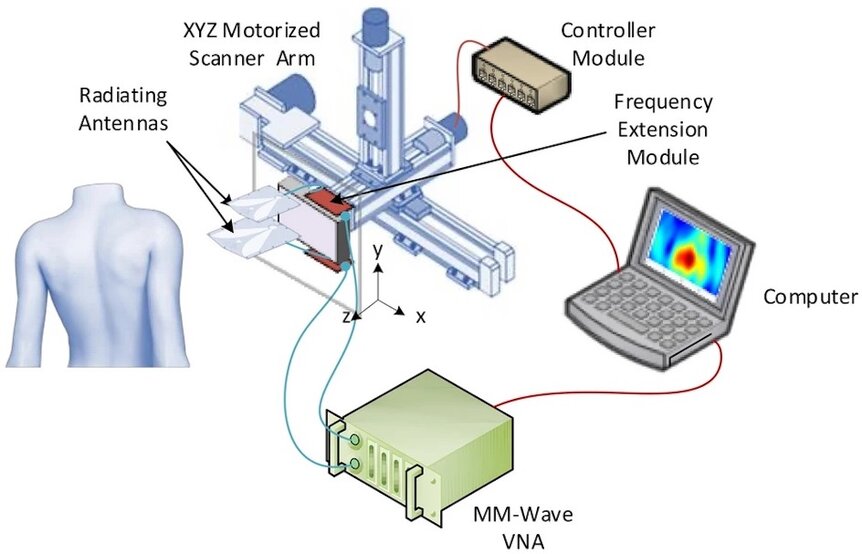Create a free profile to get unlimited access to exclusive videos, sweepstakes, and more!
Handheld ‘tricorder’ identifies cancers without biopsy
Too much sunlight might give you cancer, millimeter-wave light can find it.

The Island, starring Scarlett Johansson and Ewan McGregor, brings viewers into a sterile compound where the last remainder of humanity resides, safe from the pathogen-contaminated planet outside its walls. At least that’s what we’re told up front. The truth of the compound and the people who live there is much more sinister, but there are some elements which seem kind of nice.
Early on, Lincoln Six Echo (McGregor) wakes and uses the bathroom. His toilet seamlessly analyzes his urine, detects excess sodium, and changes his diet choices to maintain optimal health. While having your breakfast choices forcibly restricted is objectively uncool, access to effortless and non-invasive health data is something we could all benefit from.
Smart watches and other wearables have gone some distance toward recording our activity and minimal electrical data through the skin, but other diagnoses require more complicated tests. Patients visiting a doctor to check out a skin lesion, for instance, are likely to undergo a biopsy even while the odds of malignant skin cancer are relatively low. That process involves excising a piece of tissue and sending it off to a lab for analysis, leaving the patient with an open wound. Moreover, the vast majority of lesions are benign and the biopsy ultimately unnecessary. Surely, there is a better way.
Negar Tavassolian from the Department of Electrical and Computer Engineering at Stevens Institute of Technology, and colleagues, have developed a noninvasive technology which uses millimeter-light imaging to analyze skin lesions and determine whether they are benign or cancerous, without needing a biopsy. Their research was published in the journal Scientific Reports.
“Dermatologists use their eyes and instruments to magnify tissue and determine whether there is a potential for cancer. Even if they have a high confidence that a lesion is not malignant, they still send it out, because no one wants to miss a cancer. There are a lot of ongoing biopsies that are not needed,” Tavassolian told SYFY WIRE.
The new technology has the potential to vastly reduce or even eliminate unnecessary biopsies by quickly identifying malignant and benign tissues. Millimeter-wave imaging, the same technology used in airport scanners, bounces off of various tissues creating unique backscatter patterns. Cancerous tissues deliver different contrast patterns than healthy tissues, quickly identifying which lesions are in need of a closer look.
Millimeter-wave imaging won’t entirely replace biopsies, those tissues which are identified as cancerous will still require further examination by cutting out a sample, but they could eliminate the unnecessary biopsies which currently result from an abundance of caution. Getting here required new innovations in an already mature technology.
“Millimeter-wave technology hasn’t been used for biomedical applications before. The reason is the images we get don’t have enough resolution for imaging tissue layers. We invented a method to increase the resolution. With that approach, we found it could be a great fit for imaging skin cancers,” Tavassolian said.
In initial tests, the team used a large version of their device, about the size of a table, to examine 71 patients. Not only can their imaging distinguish between healthy and cancerous tissues, but it can also identify specific types of skin cancer, at rates between 88% and 100% accuracy. Now that they have a working technology, the team is working to reduce the size and the cost.
“We are using similar technology used in cell phones and circuits. We want to reduce the price and miniaturize from a tabletop to a handheld. Once that’s done, we’re going to move to clinical trials,” Tavassolian said.
The backscatter contrast exists between normal tissue and any kind of cancer, meaning the technology could feasibly be used to identify tissues beyond surface level skin lesions. Right now, the imaging depth is limited to two millimeters but if the technology can get small enough, it could even move inside the body by pairing it with a scope, to identify deeper tissues not visible from the surface.
Millimeter-wave imaging has the potential to return preliminary diagnoses in minutes without needing to cut pieces away from the body, bringing the best parts of our imagined sci-fi future firmly into reality. If, after your scan, you’re told you’ve won a trip to an island paradise, however, run!



























